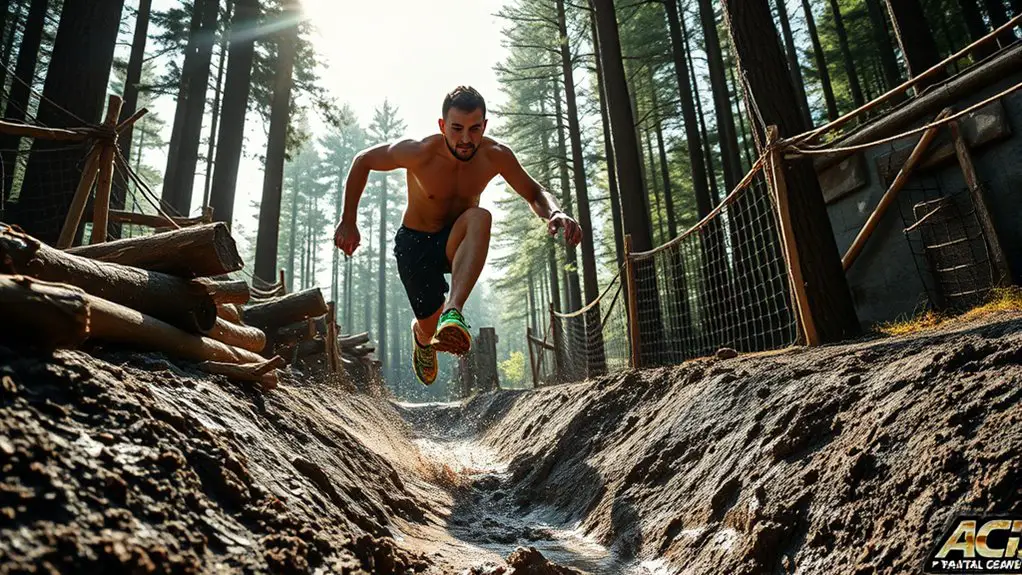Resistance parachutes improve your sprint speed by creating drag that forces your muscles to exert more effort. This added resistance enhances muscle strength, accelerates power output, and engages fast-twitch muscle fibers essential for speed. As you adapt to the increased load, you can develop better running posture and technique, promoting overall efficiency. With the right approach, you can maximize your training benefits and elevate your performance. Discover how to incorporate these powerful tools into your regimen for ideal results.
Understanding the Mechanics of Resistance Parachutes
When you think about resistance parachutes, it's essential to understand how they work to enhance your sprinting abilities. These innovative tools create drag, forcing your muscles to work harder as you sprint against the resistance. This added challenge helps you build strength and speed, giving you the freedom to push your limits.
When you strap on a resistance parachute, it's like carrying a personal windstorm. As you accelerate, the parachute opens up, providing that significant resistance. This not only trains your body but also conditions your mind to handle obstacles. You'll find that each sprint becomes a journey of growth, a way to escape your comfort zone and embrace your potential. Incorporating acceleration drills into your training can further enhance your performance alongside using resistance parachutes.
The Science of Drag and Its Impact on Speed
While resistance parachutes enhance your sprinting performance, understanding the science of drag is essential to maximizing their benefits. Drag is the force that opposes your movement through the air, and it can either hinder or help your speed. When you sprint with a parachute, you're creating additional drag, which forces your muscles to work harder. This resistance can develop your explosive strength, but if you're not aware of how drag affects your form, it might slow you down instead.
To harness the full potential of your training, you need to balance the drag created by the parachute with your natural sprinting mechanics. Focus on maintaining proper posture and stride length while battling against this resistance. The key is to push through the drag, embracing it as an opportunity to grow stronger. By mastering the interplay of drag and speed, you'll discover new levels of freedom in your sprinting performance. Additionally, incorporating plyometric exercises into your training can further enhance your explosive power and speed.
Enhancing Muscular Strength and Endurance
When you use resistance parachutes, you're not just working on speed; you're also boosting muscular strength and endurance. The added drag increases muscle activation, forcing your body to adapt and grow stronger over time. Plus, this training can enhance your aerobic capacity, enabling you to sustain high-intensity efforts for longer periods. Incorporating exercises like squats and deadlifts into your routine can further enhance overall strength and performance.
Increased Muscle Activation
Incorporating resistance parachutes into your sprint training not only boosts your speed but also markedly enhances muscle activation. This increased activation can lead you to greater muscular strength and endurance. Here's how:
- Targeted Muscle Fiber Recruitment: Resistance parachutes engage more fast-twitch muscle fibers, essential for explosive speed and power.
- Improved Neuromuscular Efficiency: The added resistance forces your nervous system to adapt, improving coordination and muscle control.
- Enhanced Muscle Endurance: Training against resistance helps your muscles adapt to fatigue, allowing you to maintain sprinting speed for longer durations.
Improved Aerobic Capacity
As you train with resistance parachutes, you'll notice a significant boost in your aerobic capacity, which plays an essential role in enhancing both muscular strength and endurance. This improvement means you can perform at higher intensities for longer periods, giving you the freedom to push your limits without feeling fatigued. With increased aerobic capacity, your body becomes more efficient at delivering oxygen to your muscles, allowing them to work harder and recover faster. You'll find that not only do your sprint times improve, but you also gain the stamina needed for longer workouts. This newfound endurance empowers you to tackle challenges head-on, transforming your training into an exhilarating journey of self-discovery and athletic prowess. Embrace the freedom that comes with enhanced performance!
Improving Running Form and Technique
Improving your running form and technique is essential for maximizing speed and reducing the risk of injury. By focusing on key elements of your stride, you can release your full potential. Here are three tips to enhance your running form:
Enhancing your running form is crucial for boosting speed and minimizing injury risk. Focus on key stride elements to unlock your potential.
- Posture: Keep your head up, shoulders relaxed, and back straight. This alignment helps maintain a smooth and efficient stride.
- Footstrike: Aim for a midfoot strike rather than landing on your heels. This promotes better energy transfer and reduces impact stress.
- Arm Movement: Use your arms to drive your legs forward. Maintain a 90-degree angle at your elbows, swinging your arms in rhythm with your legs. Additionally, focusing on core strength is crucial for maintaining control during rapid movements, which can further enhance your overall running performance.
The Role of Resistance Training in Athletic Development
Resistance training plays an essential role in your athletic development by enhancing muscle power, speed, and agility. By incorporating resistance tools like parachutes, you can improve your overall performance on the field or track. Let's explore how these benefits translate into real gains for your training regimen. Additionally, explosive power is crucial for high-level athletic performance, as it enables quick bursts of speed and strength in sports.
Benefits of Resistance Training
While many athletes focus on speed and agility drills, incorporating resistance training into your regimen can greatly enhance overall performance. This form of training builds strength and stability, allowing you to push your limits further. Here are three key benefits of resistance training:
- Increased Muscle Strength: Stronger muscles help improve your sprinting power and endurance, giving you an edge over competitors.
- Enhanced Joint Stability: Resistance exercises strengthen the muscles around your joints, reducing injury risk and promoting better movement mechanics.
- Improved Body Composition: As you build muscle, you'll also boost your metabolism, leading to leaner body composition and better athletic efficiency.
Enhancing Muscle Power
To maximize your athletic potential, enhancing muscle power through targeted resistance training is essential. This approach helps you develop explosive strength, which translates into better performance in your sprints. Resistance training isn't just about lifting weights; it's about engaging your muscles in dynamic ways.
Here's a quick overview of key resistance training methods:
| Method | Benefits |
|---|---|
| Plyometrics | Improves explosive power |
| Weightlifting | Builds overall strength |
| Resistance Bands | Increases stability |
| Bodyweight Training | Enhances functional strength |
| Sprint Drills | Boosts acceleration ability |
Speed and Agility Development
Achieving peak speed and agility requires more than just natural talent; it demands a well-rounded training approach that includes resistance training. By incorporating resistance methods, you can release your full athletic potential. Here's how:
- Increased Strength: Resistance training builds muscle strength, which directly translates to more explosive movements during sprints and agility drills.
- Improved Stability: Strengthening your core and lower body enhances stability, allowing for quicker, sharper changes in direction without losing balance.
- Enhanced Endurance: Training against resistance boosts your overall endurance, letting you maintain high-intensity efforts longer.
Embrace resistance training, and watch your speed and agility soar. It's about pushing boundaries and finding that freedom in movement. You've got the power to elevate your game!
Psychological Benefits of Training With Resistance
Training with resistance not only enhances physical capabilities but also provides significant psychological benefits that can boost your overall performance. When you incorporate resistance training, you're not just pushing your body; you're also strengthening your mind. It builds confidence, resilience, and mental toughness, allowing you to break through barriers and exceed your limits. Additionally, engaging in resistance training can help you challenge negative thoughts, empowering you to overcome self-doubt and embrace your potential.
| Psychological Benefits | Description |
|---|---|
| Increased Confidence | Achieving goals boosts self-belief. |
| Enhanced Focus | Resistance challenges sharpen your mind. |
| Reduced Anxiety | Physical exertion calms the mind. |
| Greater Motivation | Overcoming resistance fuels ambition. |
Each session with resistance brings you closer to a liberated mindset. You start to recognize your potential, and that realization can spark a fierce drive to achieve your dreams. Embrace these psychological gains, and let them propel you towards your ultimate goals.
Tailoring Resistance Parachute Workouts for Optimal Results
While resistance parachutes can greatly enhance your sprint speed, tailoring your workouts to meet your specific needs is essential for best results. To get the most out of your training, consider these three key factors:
Enhance your sprint speed with tailored workouts focusing on intensity, rest, and varied drills for optimal results.
- Intensity and Duration: Adjust the intensity of your sprints and the duration of your sessions. Shorter, more intense bursts can improve speed, while longer runs can build endurance.
- Rest Intervals: Don't underestimate the power of rest. Incorporate adequate recovery between sprints to maximize your performance during each effort.
- Variety of Drills: Mix up your workouts with different drills, like acceleration sprints, hill runs, or agility exercises. This keeps your training dynamic and challenges your body in new ways. Additionally, incorporating dynamic stretching into your warm-up routine can further prepare your muscles for high-intensity efforts.
Common Mistakes to Avoid When Using Resistance Parachutes
When using resistance parachutes, it's easy to make mistakes that can hinder your progress. You might overlook the importance of choosing the right parachute size, or neglect your running form and warm-up routine. A proper warm-up is essential to prepare your muscles and reduce the risk of injuries, so let's explore these common pitfalls so you can maximize your training effectiveness.
Incorrect Parachute Size
Choosing the right size resistance parachute is essential for maximizing your sprint training. Using an incorrect size can hinder your performance and limit your progress. Here are three common mistakes to avoid:
- Too Small: A parachute that's too small won't provide enough resistance, diminishing the benefits of your training.
- Too Large: If the parachute is too large, it may create excessive drag, making it hard to maintain your speed and form.
- Ignoring Weight: Consider your body weight; a parachute that doesn't match your size and strength can lead to ineffective training sessions.
Poor Running Form
Using the right size resistance parachute is just the beginning; maintaining proper running form is equally important for maximizing your training benefits. If you're focused on speed, you can't afford to let poor form hold you back. Keep your head up, shoulders relaxed, and arms pumping naturally. Avoid overextending your strides, as that can waste energy and slow you down. Instead, focus on quick, powerful steps that keep you grounded and connected to the ground. Remember, while the parachute adds resistance, your technique should still feel fluid and effortless. It's all about harnessing that freedom to express your speed. So, pay attention to your form, and let the parachute enhance your natural abilities rather than hinder them.
Inadequate Warm-Up Routine
Although many athletes are enthusiastic to start sprinting with resistance parachutes, skipping a proper warm-up can lead to injuries and hinder performance. To maximize your training and stay injury-free, consider these essential warm-up elements:
- Dynamic Stretching: Engage in movements like leg swings or arm circles to loosen up your muscles and joints.
- Gradual Acceleration: Start with light jogging, building up to faster strides. This prepares your body for the intensity of sprinting.
- Activation Drills: Incorporate exercises like high knees or butt kicks to activate the muscles you'll use during sprints.
Real-World Success Stories: Athletes Who Have Benefited
Many elite athletes have transformed their speed and performance through resistance parachute training, showcasing its effectiveness in real-world scenarios. Take sprinters like Usain Bolt, who've credited their explosive acceleration to this innovative training technique. You could see similar benefits in your own sprinting by incorporating parachute drills.
Here's a quick look at some athletes and their improvements:
| Athlete | Performance Gain |
|---|---|
| Usain Bolt | Enhanced acceleration |
| Allyson Felix | Improved endurance |
| Justin Gatlin | Faster sprint times |
These success stories illustrate how resistance parachutes can release your potential, allowing you to break barriers and achieve new personal records. By embracing this training method, you're not just chasing speed; you're gaining the freedom to push your limits and redefine what's possible in your athletic journey. Incorporating plyometric training can further enhance your explosiveness and overall performance.
Integrating Resistance Parachutes Into Your Training Regimen
To maximize the benefits of resistance parachutes, it's essential to seamlessly integrate them into your existing training regimen. These parachutes can elevate your sprinting game, but balance is key. Here's how you can incorporate them effectively:
Maximize your sprinting potential by integrating resistance parachutes into your training for balanced and effective workouts.
- Warm-up First: Always start with a solid warm-up to prepare your muscles and prevent injuries. Spend at least 10 minutes on dynamic stretches and light jogging.
- Alternate Drills: Mix parachute sprints with regular sprints to build endurance and power. For instance, alternate between 30-meter sprinting with the parachute and 30-meter sprints without it.
- Focus on Technique: When using the parachute, pay attention to your form. Proper running mechanics guarantee that you're not just working harder, but smarter, making every sprint count. Additionally, incorporating interval training into your routine can enhance your overall speed and endurance.
Frequently Asked Questions
Can Resistance Parachutes Be Used for Other Sports Besides Sprinting?
Oh, sure! Why not? You could use resistance parachutes in underwater basket weaving too! But really, they're fantastic for any sport needing explosive speed, agility, or strength. Embrace your freedom to train creatively, my friend!
How Much Resistance Should I Start With for Optimal Training?
You should start with a resistance that feels challenging but manageable—around 10-15% of your body weight. As you get stronger, gradually increase the resistance to keep pushing your limits and enhancing your performance.
Are There Age Restrictions for Using Resistance Parachutes Effectively?
There aren't strict age restrictions for using resistance parachutes, but you should consider individual fitness levels, physical maturity, and injury history. It's always best to consult with a coach or trainer before starting.
How Often Should I Incorporate Parachute Training Into My Routine?
You should incorporate parachute training into your routine two to three times a week. This frequency allows you to build strength and speed without overtraining, giving you the freedom to enjoy your workouts and see progress.
What Safety Precautions Should I Take When Using Resistance Parachutes?
Before you harness the power of resistance parachutes, make certain you're on a flat surface, use a spotter for safety, and check equipment regularly. Remember, freedom in training thrives best with caution and awareness at every turn.




